Antennarius
Theodore W. Pietsch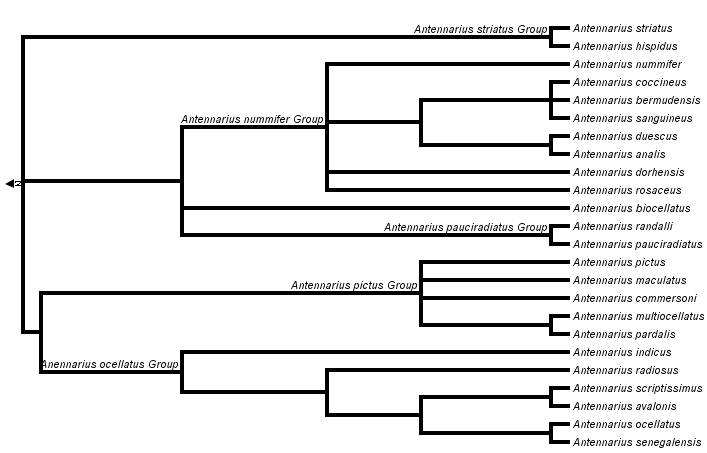


This tree diagram shows the relationships between several groups of organisms.
The root of the current tree connects the organisms featured in this tree to their containing group and the rest of the Tree of Life. The basal branching point in the tree represents the ancestor of the other groups in the tree. This ancestor diversified over time into several descendent subgroups, which are represented as internal nodes and terminal taxa to the right.

You can click on the root to travel down the Tree of Life all the way to the root of all Life, and you can click on the names of descendent subgroups to travel up the Tree of Life all the way to individual species.
For more information on ToL tree formatting, please see Interpreting the Tree or Classification. To learn more about phylogenetic trees, please visit our Phylogenetic Biology pages.
close boxIntroduction
As presently understood, Antennarius is an assemblage of 24 species that fall conveniently into six species-groups. Like most other members of the family Antennariidae, fishes of the genus Antennarius spend the greater part of their lives squatting on the bottom in shallow water. These fishes are found worldwide in tropical and subtropical waters. Despite their sedentary nature, nearly all are voracious carnivores that sit quietly waiting for smaller fishes to pass by, at which time they enticingly wriggle their bait to attract the potential prey to their cavernous mouths. Their ovaries are tightly rolled like a double scroll, and eggs are released embedded in a single, large, buoyant gelatinous mass. Besides their value in the aquarium trade, they are of no significant economic interest.
Whereas monophyly for each of the six species-groups can be supported by one or more synapomorphies, Pietsch and Grobecker (1987) were unable to find any convincing synapomorphic features to establish monophyly for the genus. Thus, Antennarius is defined by a combination of what appear to be primitive character states.
Characteristics
Diagnosis
Antennarius is unique among antennariids in having the following combination of character states: skin covered with close-set, bifurcate dermal spinules, the length of spines of each spinule not more than twice the distance between tips of spines; illicium naked, without dermal spinules (except at extreme base, or confined to a narrow row of spinules along anterior margin, as in some species of A. ocellatus and A. nummifer groups); esca distinct; pectoral lobe broadly attached to side of body; caudal peduncle present or absent; all rays of caudal fin bifurcate; mesopterygoid present; pharyngobranchial I present; epural present; pseudobranch present; swimbladder present; dorsal rays 11–14; anal rays 6–10; pectoral rays 8–14.
Description
Escal morphology highly variable; illicium, when laid back onto head, usually fitting into a narrow, naked groove situated on either left or right side of second dorsal spine, the tip of illicium (esca) usually (but not in members of the A. pictus Group) coming to lie within a shallow depression (sometimes devoid of dermal spinules) between second and third dorsal spines, the esca capable of being covered and protected by second dorsal spine when spine is fully depressed (esca of members of the A. pictus Group perhaps protected in similar way by third dorsal spine); illicial length highly variable, ranging from considerably less than length of second dorsal spine to slightly more than twice its length, 5.0–33.8% SL; anterior end of pterygiophore of illicium terminating considerably posterior to, or extending anteriorly considerably beyond, symphysis of upper jaw; illicium and second dorsal spine relatively closely spaced on pterygiophore, the distance between bases of spines less than 5% SL; second dorsal spine straight to strongly curved posteriorly, free or connected to head by membrane, length 6.8–20.6% SL; third dorsal spine curved posteriorly, tapering slightly toward distal end, the full length connected to head by membrane, length 15.3–31.7% SL; eye not distinctly surrounded by separate clusters of dermal spinules, diameter 2.6–11.4% SL; usually distal 2/3 of maxilla naked and tucked beneath folds of skin, only extreme proximal end directly covered with spinulose skin (only distal tip, approximately 20–25% of length of maxilla, naked and tucked beneath folds of skin in members of the A. ocellatus Group); cutaneous appendages scattered over head, body, and fins, their development highly variable); wart-like patches of clustered dermal spinules absent; caudal peduncle usually present (but absent in some members of the A. nummifer Group); epibranchial I toothless (a few tiny remnants of tooth-plates present in some specimens); ceratobranchial I toothless; vertebrae 19 or 20, caudal centra 14 or 15; dorsal 11–14, all simple to all bifurcate; anal rays 6–10, all bifurcate; pectoral rays 8–14, all simple or all bifurcate; posteriormost ray of pelvic fin simple or bifurcate.
Color in preservation highly variable.
Discussion of Phylogenetic Relationships
The interrelationships of the six species-groups of Antennarius remain unknown and the species-groups are arranged in the key and the above cladogram solely on the basis of increasing relative specialization. Although each can be defined on the basis of one or more synapomorphies, no group of two or more species-groups possesses any known synapomorphy that does not also occur within other taxa of the genus.
Key to the Species-groups of Antennarius
This key, like the key to antennariid genera on the family-level page, works by progressively eliminating the most derived taxon, and for that reason should always be entered from the beginning. All features listed for each species-group must correspond to the specimen being keyed; if not, proceed to the next set of characters. The figures accompanying the key are diagrammatic; dermal spinules and cutaneous appendages (with minor exceptions) are not shown.
| 1. Illicium distinctly shorter than second dorsal spine, the later broadly connected to third spine, and the third broadly connected to the soft-dorsal fin by thin membranous skin; individuals small, not larger than about 40 mm SL (Antennarius pauciradiatus Group, Western Atlantic; Western Pacific to Easter Island) | 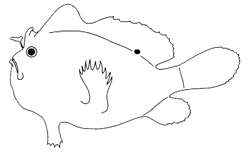 |
| 2. Illicium usually slightly shorter than second dorsal spine, the latter free, not connected to head by membrane, broad-based, more or less straight and tapering to a point; a darkly pigmented, basidorsal ocellus encircled by a lightly pigmented ring nearly always present; conspicuous cutaneous appendages on chin; pectoral rays 9, rarely 8 or 10 (Antennarius biocellatus Group, Western Pacific) |  |
| 3. Second dorsal spine free, not connected to head by membrane, the posterior surface often naked, devoid of dermal spinules; a darkly pigmented, basidorsal pigment spot often present, but only rarely encircled by a lightly pigmented ring; anterior end of pterygiophore of illicium terminating distinctly posterior to symphysis of upper jaw; individuals small, not exceeding about 95 mm SL (Antennarius nummifer Group, Atlantic, Pacific, and Indian oceans) | 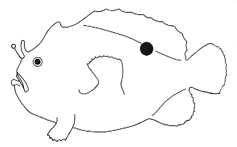 |
| 4. Illicium about equal to length of second dorsal spine, the latter membranously attached to head, the membrane nearly always divided into naked dorsal and ventral portion by a dense cluster of dermal spinules; only distal 20-25% of maxilla naked and tucked beneath folds of skin, the remaining proximal portion covered directly with spinulose skin; 1 to 3, prominent, dark ocelli on side of body, each encircled by a lightly pigmented ring; pectoral rays 12-14 (rarely 11), usually all bifurcate; anal rays 8-10 (rarely 7); usually all rays of pelvic fin bifurcate (Antennarius ocellatus Group, Atlantic, Pacific, and Indian oceans) | 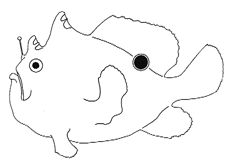 |
| 5. Illicium approximately twice length of second dorsal spine, the latter membranously attached to head, the membrane not divided into naked dorsal and ventral portion by a dense cluster of dermal spinules; anterior end of pterygiophore of illicium terminates distinctly posterior to symphysis of upper jaw; pectoral rays 10 or 11, never bifurcate; head, body, and fins often with dark, circular spots of pigment (caudal fin often with triangle of 3 large spots), never covered with roughly parallel, darkly pigmented streaks. (Antennarius pictus Group, Atlantic, Pacific, and Indian oceans) | 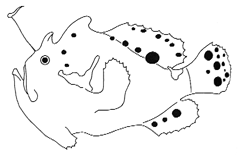 |
| 6. Illicium about as long as second dorsal spin, the latter membranously attached to head, the membrane not divided into naked dorsal and ventral portions by a dense cluster of dermal spinules; anterior end of pterygiophore of illicium nearly always extending anteriorly beyond symphysis of upper jaw, slightly overhanging the mouth; esca consisting of 2 to 7 elongate, worm-like appendages or an oval-shaped tuft of numerous fine filaments; head, body, and fins usually completely covered with roughly parallel, darkly pigmented streaks (Antennarius striatus Group, Atlantic and Indo-Pacific oceans) |  Drawings © 1987 Theodore W. Pietsch |
References
Pietsch, T. W., and D. B. Grobecker. 1987. Frogfishes of the World: Systematics, Zoogeography, and Behavioral Ecology. Stanford University Press, Stanford, xxii + 420 pp.
Title Illustrations

| Scientific Name | Antennarius striatus |
|---|---|
| Location | Australia |
| Acknowledgements | Photo courtesy of D. Harasti |
| Specimen Condition | Live Specimen |
| Copyright | © 2004 D. Harasti |
About This Page
Theodore W. Pietsch

University of Washington, Seattle, Washington, USA
Correspondence regarding this page should be directed to Theodore W. Pietsch at and Christopher P. Kenaley at
Page copyright © 2005 Theodore W. Pietsch
 Page: Tree of Life
Antennarius.
Authored by
Theodore W. Pietsch.
The TEXT of this page is licensed under the
Creative Commons Attribution-NonCommercial License - Version 3.0. Note that images and other media
featured on this page are each governed by their own license, and they may or may not be available
for reuse. Click on an image or a media link to access the media data window, which provides the
relevant licensing information. For the general terms and conditions of ToL material reuse and
redistribution, please see the Tree of Life Copyright
Policies.
Page: Tree of Life
Antennarius.
Authored by
Theodore W. Pietsch.
The TEXT of this page is licensed under the
Creative Commons Attribution-NonCommercial License - Version 3.0. Note that images and other media
featured on this page are each governed by their own license, and they may or may not be available
for reuse. Click on an image or a media link to access the media data window, which provides the
relevant licensing information. For the general terms and conditions of ToL material reuse and
redistribution, please see the Tree of Life Copyright
Policies.
- First online 01 November 2005
Citing this page:
Pietsch, Theodore W. 2005. Antennarius. Version 01 November 2005 (under construction). http://tolweb.org/Antennarius/52009/2005.11.01 in The Tree of Life Web Project, http://tolweb.org/




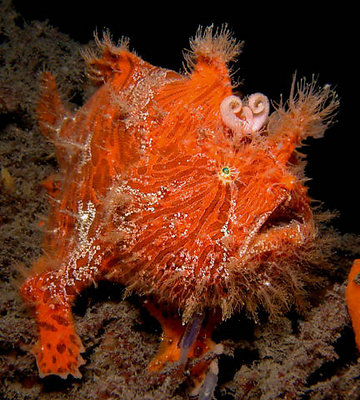


 Go to quick links
Go to quick search
Go to navigation for this section of the ToL site
Go to detailed links for the ToL site
Go to quick links
Go to quick search
Go to navigation for this section of the ToL site
Go to detailed links for the ToL site